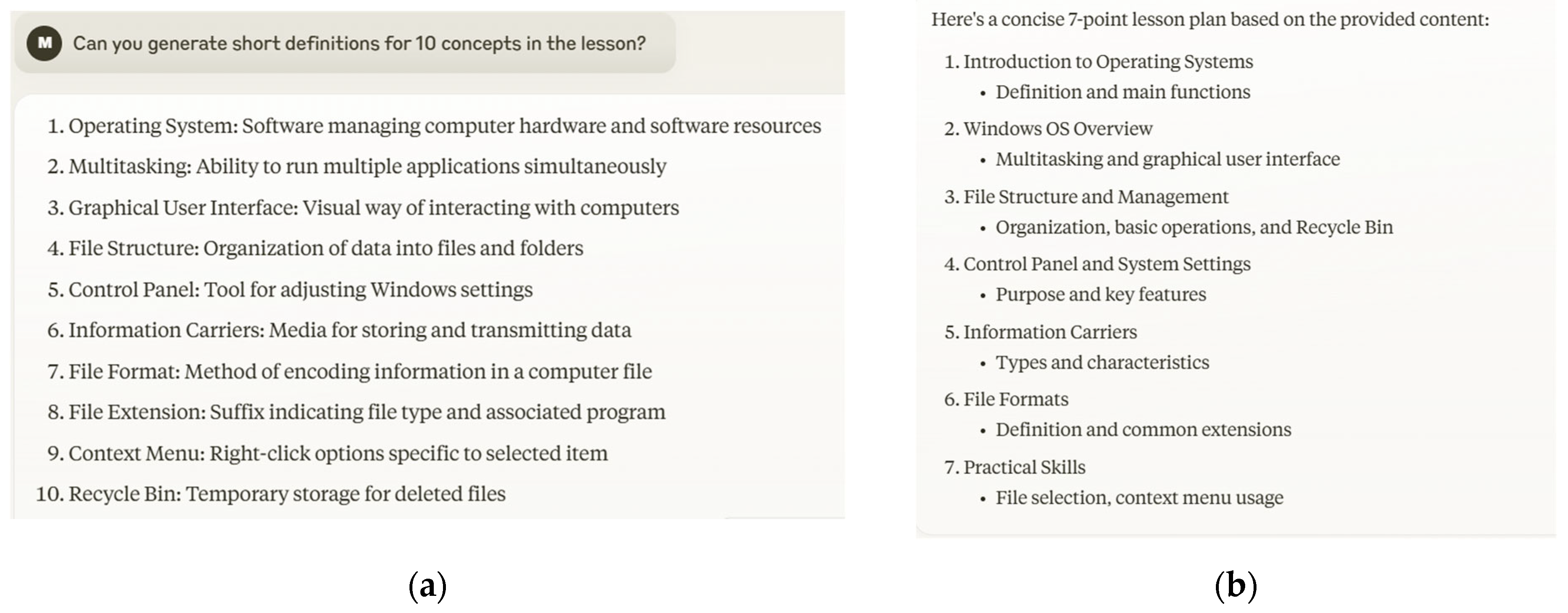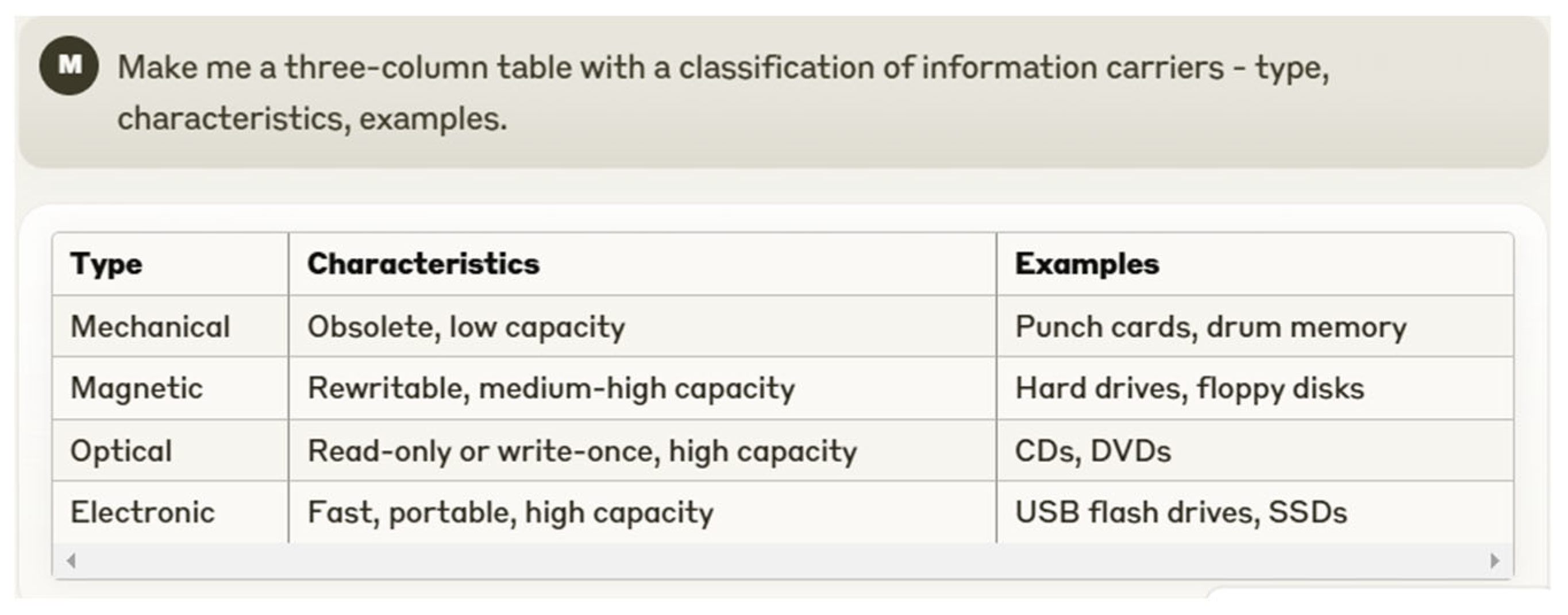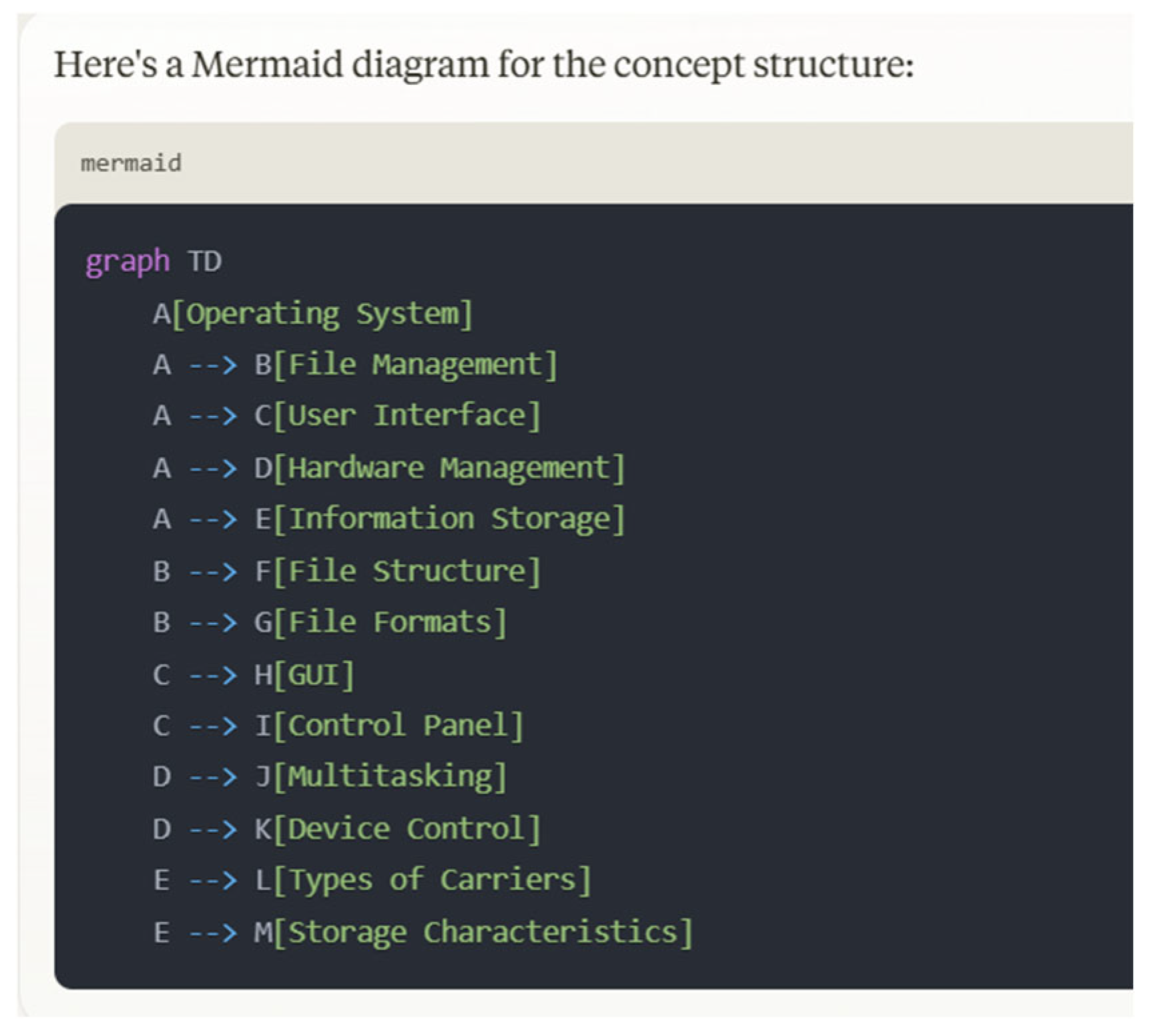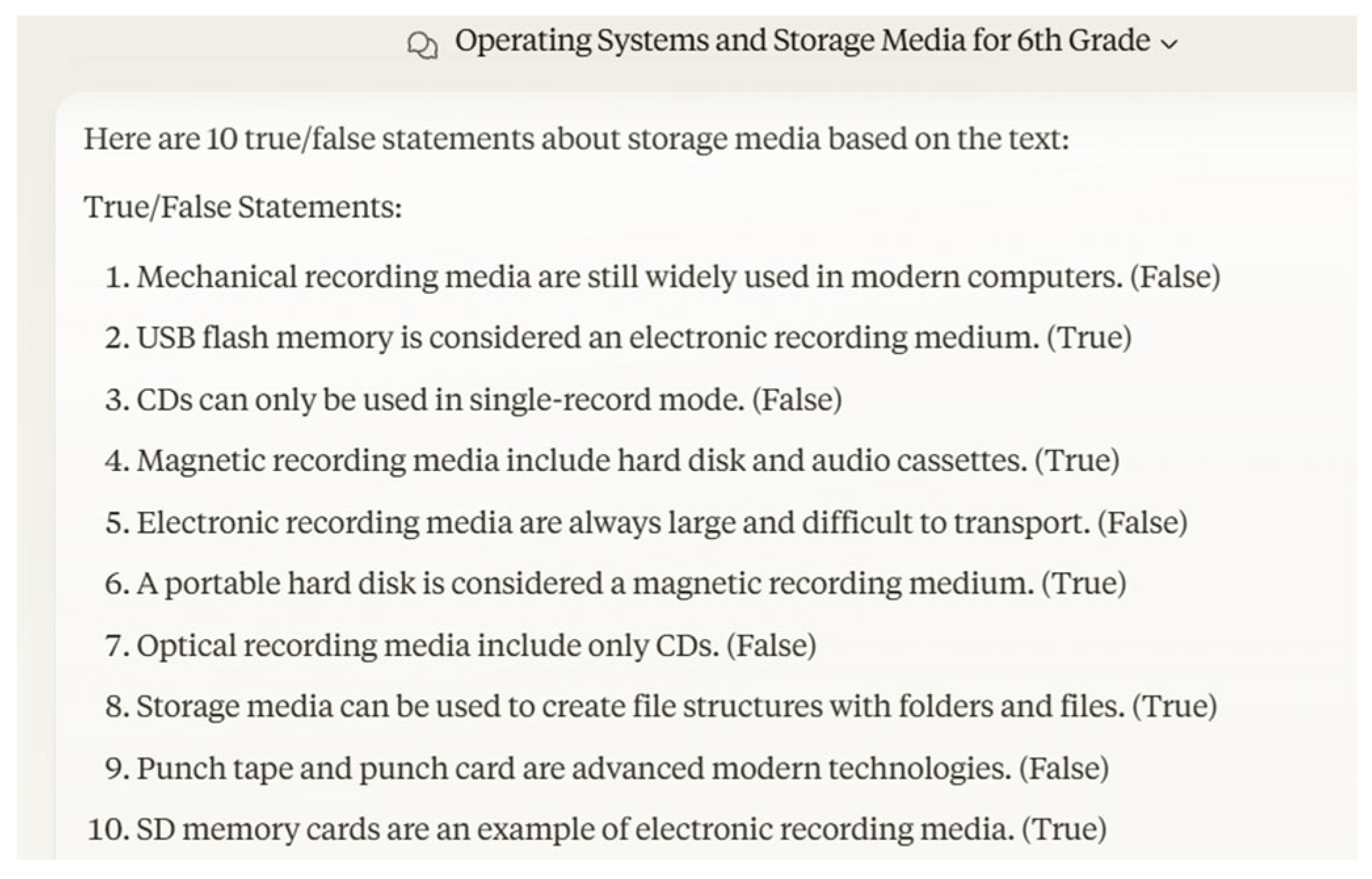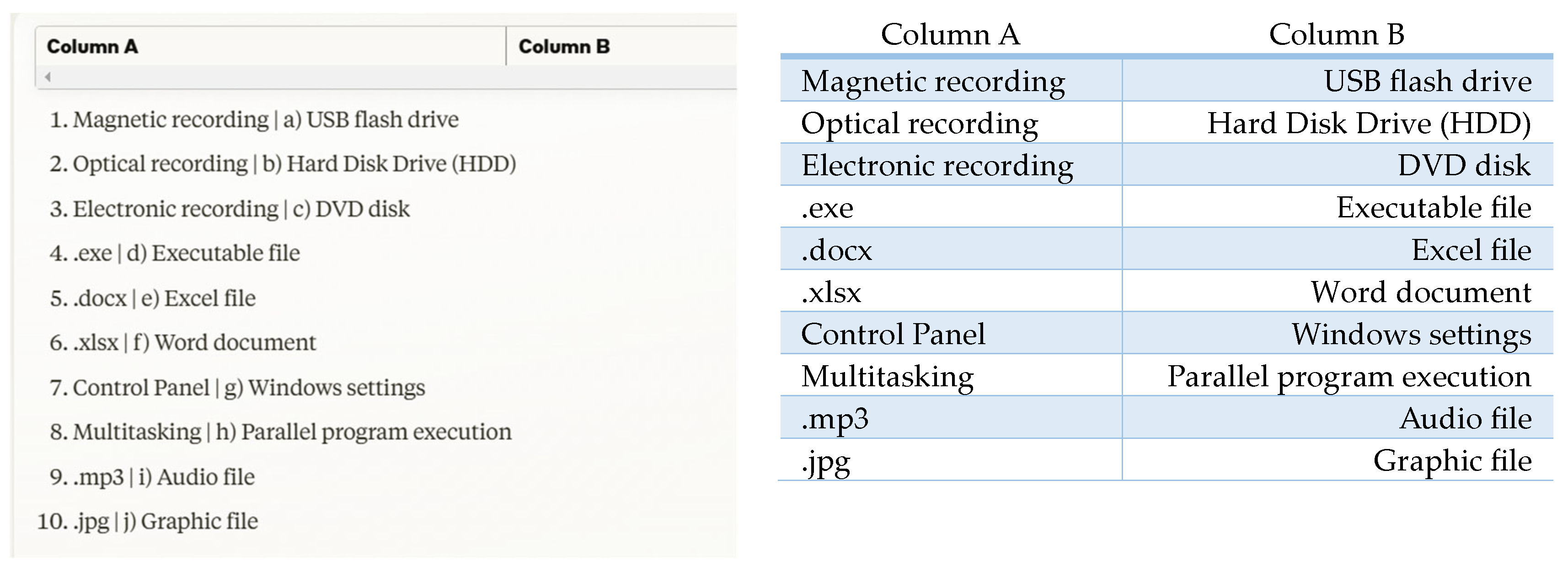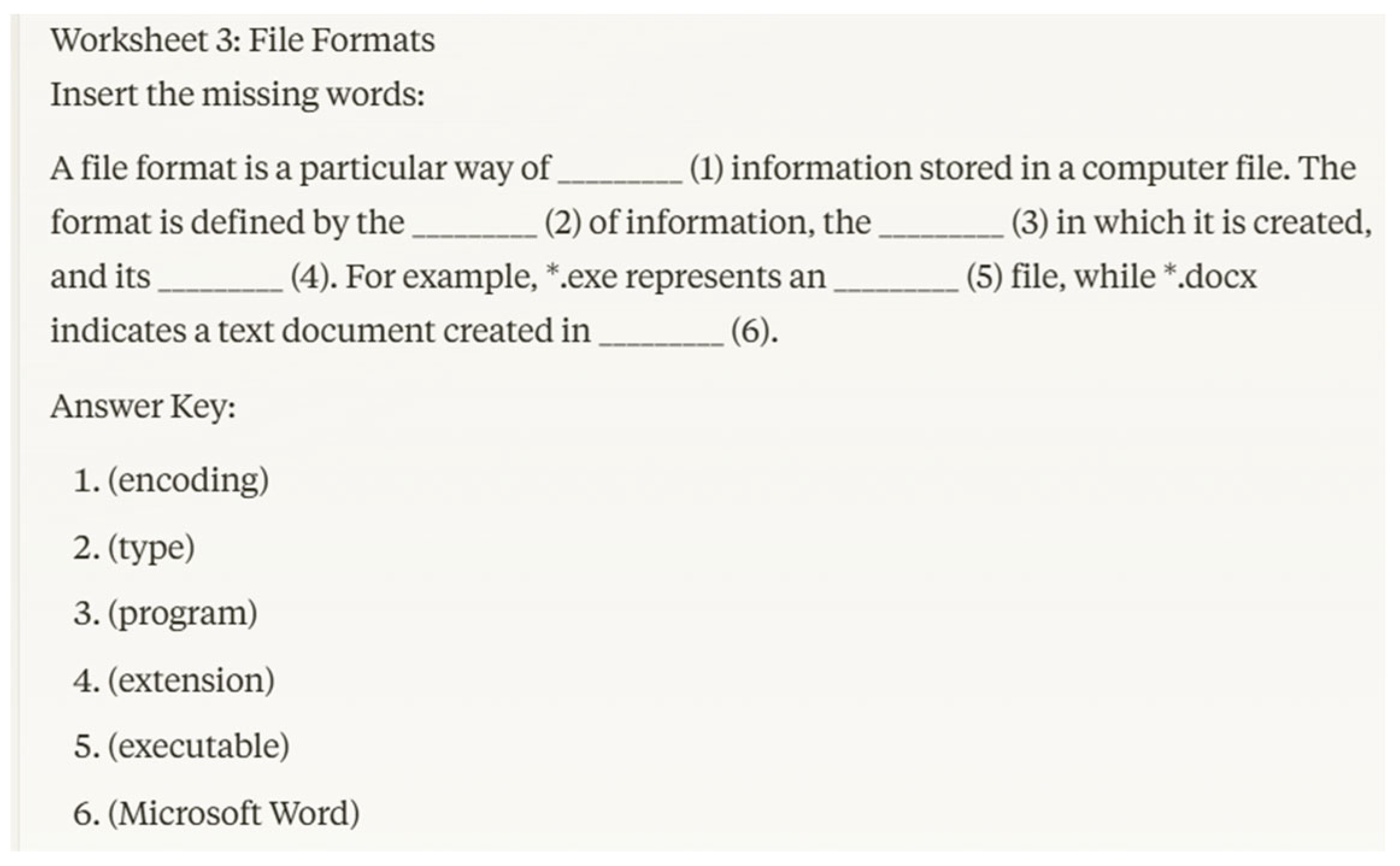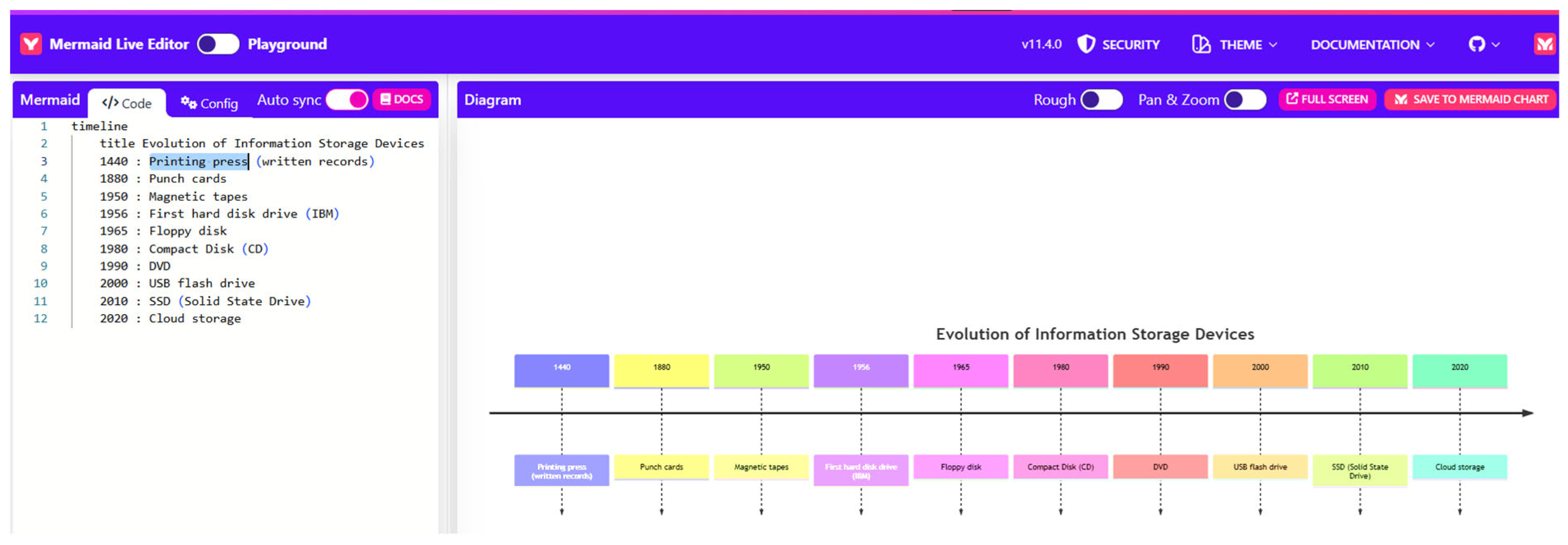1. Introduction
Modern digital technologies enable the generation of educational resources that include various elements (text, images, animation, 3D models, audio, and video). Integrating diverse media formats into learning stimulates students’ visual, auditory, and practical perception through active interaction with learning content. Multimedia learning materials meet the needs of learners with different learning styles and content acquisition.
Multimodal learning is defined as a learning environment that allows learning elements to be presented in more than one sensory mode [
1]. Multimodal theory focuses on how different modes (image, sound, text, speech, gesture) are combined and viewed as organized sets of resources with meaning that is more than the sum of all modes of meaning [
2]. Modern technologies are essential for creating multimodal resources. They allow teachers to generate learning content in different formats, tailored to the learners’ needs and preferences. Information technology teachers must possess competencies for creating quality digital resources and key skills for understanding the principles of multimodal learning. The generative AI tools support teachers in designing multimodal resources, but require training for effective use to evaluate generated content in different formats and modes and adapt it to specific educational goals.
2. Digital Technologies for Multimodal Learning
Each learner has individual characteristics, a specific learning style, and knowledge acquisition, which requires learning to be adapted and personalized to their needs and preferences. Learning in a digital environment allows the use of learner-centered approaches that make students active participants. In line with active learning and learner-centered approaches, multimodality is viewed as a “multiple” mode of presenting learning content with combined elements of text and visual images [
3].
Digital technologies play a significant role in multimodal learning. In a digital environment, the use of modern information and communication technologies in learning contributes to the development of a multimodal, active, and learner-centered approach [
3]. The integration of digital technologies in education provides educators with opportunities to present educational content in different formats (text, images, video, audio) according to the needs of learners and their learning styles, which can lead to increased motivation for learning and improved outcomes. The pervasive penetration of digital technologies allows educators to integrate elements based on diverse modes of content presentation [
4]. The presentation of educational content in multiple modes makes it possible for learners to use those that best suit their individual preferences and learning styles. Assessment strategies should also be multimodal to ensure objectivity [
4].
The presentation of content in different forms stimulates learner engagement and enhances the understanding and memorization of learning material [
1]. Multimodal presentation of learning content increases learners’ intrinsic motivation, but also leads to greater cognitive load [
5].
3. Methodology
Pre-service teachers in IT subjects have to possess competencies for creating quality digital resources. During their training, challenges related to the development of methodological materials are observed. The following areas of difficulty are identified.
Transformation of educational content into alternative formats (e.g., extraction of key concepts, conceptualization of definitions);
Formulation of questions for updating prior knowledge;
Development of questions for systematization and summary of learning material;
Structuring logical sequences in the process description.
To overcome difficulties, an approach based on the use of artificial intelligence (AI) tools has been developed. The widespread use of AI tools and their promising capabilities for assistance in various areas imply the need to form students’ skills for their use. The proposed methodology involves applying AI to pre-selected learning content aligned with the 6th-grade IT curriculum. This approach was used with a dual purpose. By limiting the AI-generated content within the 6th-grade IT curriculum, the risk of going beyond the intended learning content and educational goals was minimized, and the critical assessment of the AI-generated resources by students based on their prior knowledge of the learning material was facilitated. This method allows future educators to develop skills for effectively integrating AI tools into the educational process while maintaining control over the pedagogical adequacy of the generated content.
Students were assigned to prepare multimodal learning resources using an AI tool (Claude.ai) [
6] on the topic “Operating System and Data storage”. The selected topic from the learning content for 6th grade is fundamental for working with all IT applications. The prompts to AI are divided into two groups: generating content to facilitate the perception of learning content and generating content to diversify activities in the classroom. The students experimented with the capabilities of AI to generate multimodal resources on the topic, presenting the same learning content in different ways. AI requests to facilitate the perception of educational content include ‘Systematized text with definitions’, ‘Lesson plan’, ‘Classification tables’, and ‘Logical connection schemes’. To diversify educational activities, requests were defined to generate tasks: true/false statements, concept connections, and gap filling.
4. Results and Discussion
As a result of the experiment, students generated educational resources with AI tools.
Students showed the highest satisfaction with the generation of systematized text definitions of the main concepts and a variant of a lesson plan for students. These resources rarely needed editing and were used successfully during the lesson (
Figure 1).
The generated classification tables required conversion to the traditional table structure (
Figure 2). Post-processing of the content, including formatting and editing, was required in the classification visualization process. In contrast, with the same table creation request, another AI tool (
https://bggpt.ai/) (accessed on 30 January 2025) [
7] was used to generate the table that can be copied and pasted into a text file without the need for conversion.
The generated diagrams illustrate logical connections and sequences. They were presented in text files with the extension .mermaid, which contained code for creating diagrams (
Figure 3). The proposed code could be copied into Mermaid Live Editor [
8], where the diagram was visualized with the ability for editing (
Figure 4). The finished diagram was downloaded as a portable network graphics file. This option provoked the greatest interest among students, and they repeatedly experimented with different data for constructing diagrams.
The generated format satisfied students, as they used it without requiring additional formatting (
Figure 5).
The generated resource concept matching task in a two-column table format was used to embed in a worksheet. It required additional formatting (borders, alignment, coloring, etc.) (
Figure 6). The suggested concepts in two columns can be used to create a pair-matching exercise using other applications, for example, LearningApps [
9].
The generated gap-filling task was appreciated by students because it was easily used to embed in a worksheet or create an exercise in LearningApps (
Figure 7). In the experiment with the learning content, some students received a suggestion from AI to build a timeline. The generated resource was a code used in Mermaid Live Editor for visualization and editing (
Figure 8).
The quality of systematized texts and lesson plans was high. The generated tables and diagrams needed additional formatting before using them in learning activities. Created tasks could be integrated into other interactive exercises. AI tools have been proven to be capable of generating additional resources. Multimodal resources generated by AI tools need improvements and modifications for illustrating and diversifying learning activities. Students who use AI to generate multimodal learning resources need to have skills in formulating appropriate prompts and requests to AI to receive different options for presenting learning content. To effectively use AI-generated resources, they need competencies to edit text and non-text objects in various applications and work with Web-based applications to transform AI-generated code into an image or diagram. Students need skills for further processing of generated resources into a format to create quiz tasks and exercises.
In line with the multimodal approach to learning, strategies for students’ assessment need to be diverse and engage different cognitive processes. AI tools play a key role in preparing a variety of assessment materials. AI helps teachers generate multiple question variants on a given topic, create templates for tables and diagrams, suggest elements for classification and grouping, generate logical sequences, and create correspondence tasks.
5. Conclusions
With the introduction of digital technologies in education, learning materials are becoming more multimodal, interactive, and technologically mediated [
1]. Using AI tools to generate multimodal resources is useful for pre-service teachers in IT subjects. AI facilitates their preliminary preparation for presenting lessons and providing diverse resources for students to visualize and make sense of the IT educational content. AI tools facilitate routine activities related to the transformation of educational content into multimodal formats, but the role of teachers is essential. During editing, formatting, and post-processing of the generated content, pre-service teachers have the opportunity to optimize it by using specialized applications and Web platforms to create interactive exercises.
Using a familiar topic from the IT educational content, as well as submitting ready-made content by AI, students can check the accuracy of the generated results independently. The use of AI to create multimodal learning resources offers significant opportunities for enriching the learning experience. However, their effective implementation requires specific teachers’ competencies and careful integration into pedagogical practice. The results of this study highlight the need to develop specific competencies in future teachers: skills for formulating effective requests to AI, critical evaluation and adaptation of generated content, and technical skills for processing different types of digital resources.
Author Contributions
Conceptualization, G.K. and M.T.; methodology, G.K. and M.T.; software, M.T.; validation, G.K. and M.T.; writing—original draft preparation, G.K. and M.T.; writing—review and editing, G.K. and M.T.; funding acquisition, G.K. All authors have read and agreed to the published version of the manuscript.
Funding
This study was funded by the European Union-NextGenerationEU, in the frames of the National Recovery and Resilience Plan of the Republic of Bulgaria, first pillar “Innovative Bulgaria”, through the Bulgarian Ministry of Education and Science (MES), Project No. BG-RRP-2.004-0006-C02 “Development of research and innovation at Trakia University in service of health and sustainable well-being”, subproject “Digital technologies and artificial intelligence for multimodal learning—a transgressive educational perspective for pedagogical specialists” No. H001-2023.47/23.01.2024.
Institutional Review Board Statement
Not applicable.
Informed Consent Statement
Informed consent was obtained from all subjects involved in the study.
Data Availability Statement
The data presented in this study are available on request from the corresponding author.
Conflicts of Interest
The authors declare no conflicts of interest.
References
- Sankey, M.; Birch, D.; Gardiner, M.W. Engaging students through multimodal learning environments: The journey continues. In Proceedings of the 27th Australasian Society for Computers in Learning in Tertiary Education, Sydney, Australia, 5–8 December 2010; pp. 852–863. [Google Scholar]
- Öman, A.; Hashemi, S.S. Design and redesign of a multimodal classroom task—Implications for teaching and learning. J. Inf. Technol. Educ. Res. 2015, 14, 139. [Google Scholar]
- Philippe, S.; Souchet, A.D.; Lameras, P.; Petridis, P.; Caporal, J.; Coldeboeuf, G.; Duzan, H. Multimodal teaching, learning and training in virtual reality: A review and case study. Virtual Real. Intell. Hardw. 2020, 2, 421–442. [Google Scholar] [CrossRef]
- Bouchey, B.; Castek, J.; Thygeson, J. Multimodal learning. In Innovative Learning Environments in STEM Higher Education: Opportunities, Challenges, and Looking Forward; Springer: Cham, Switzerland, 2021; pp. 35–54. [Google Scholar]
- Luo, H. Advances in multimodal learning: Pedagogies, technologies, and analytics. Front. Psychol. 2023, 14, 1286092. [Google Scholar] [CrossRef] [PubMed]
- Claude. Available online: https://claude.ai/ (accessed on 30 January 2025).
- BgGPT. Available online: https://bggpt.ai/ (accessed on 30 January 2025).
- Mermaid Live Editor. Available online: https://mermaid.live/ (accessed on 30 January 2025).
- LearningApps.Org. Available online: https://learningapps.org (accessed on 30 January 2025).
| Disclaimer/Publisher’s Note: The statements, opinions and data contained in all publications are solely those of the individual author(s) and contributor(s) and not of MDPI and/or the editor(s). MDPI and/or the editor(s) disclaim responsibility for any injury to people or property resulting from any ideas, methods, instructions or products referred to in the content. |
© 2025 by the authors. Licensee MDPI, Basel, Switzerland. This article is an open access article distributed under the terms and conditions of the Creative Commons Attribution (CC BY) license (https://creativecommons.org/licenses/by/4.0/).
